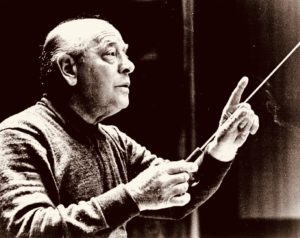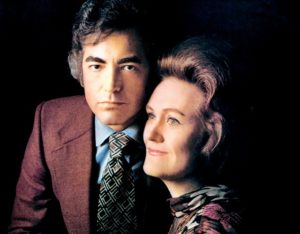Newsletter article by Douglas Blackstone
Conductors Good & Bad, or at all?
By Douglas Blackstone
When I was an active member of a symphony orchestra, I often got the question: “What does the conductor really do?” This was asked with the notion that it was difficult for the average concert attendee and listener to quantify a conductor’s actual contribution to the success of the concert!
Well, we’ve heard of the conductor-less Orpheus Chamber Orchestra, so it must be possible for an ensemble to play without one. In my experience, though, I would rather have a conductor—but a good one.
So, what does an orchestra want in a good conductor? I’ve thought about this a lot, and here’s my take: The orchestra wants a conductor who knows as much about the music as they do—and hopefully more. There are few who inspire musicians in this way, but here are several for whom I was lucky enough to play:
Eugene Ormandy

Eugene Ormandy photographed by Adrian Siegel for the Philadelphia Orchestra
I received my Bachelor’s and Master’s degrees from Temple University’s music school, so I spent 6 happy years playing horn in Philadelphia and heard the orchestra with Ormandy many times. I never played in the Philadelphia Orchestra, but Ormandy conducted the Temple Orchestra a few times, and I also played for him in the Curtis orchestra.
The Curtis Orchestra at that time did not give concerts. It was a true training orchestra, but they only had 4 horn players, so whenever they did big works, I, and others, were fortunate to be asked to play. The arrangement was that whoever was conducting the Philly Orchestra that weekend would come in and rehearse the same program at Curtis.
On this particular weekend, Ein Heldenleben, Strauss’ huge tone poem, was on, and it requires eight horns. I played 7th. There was a warm-up rehearsal on Thursday so that we were “ready” for Ormandy, and that rehearsal was conducted by William (Bill) Smith, the Asst. Conductor and fine pianist of the Philadelphia Orchestra. He himself was an excellent conductor and a real gentleman. Bill Smith told us that there was a mistake in the score in one of the big chords that punctuate the opening bars of Heldenleben, and that we should play the printed notes to see if Ormandy caught it. The mistake was in the 7th Horn part! Ormandy caught it and stopped the orchestra to say, “7th horn, there’s a mistake in your part; please play the penciled note.” That’s pretty impressive. There were more examples in my brief experience with Ormandy, and it became clear that he had perfect pitch, which was very handy, particularly with vocal soloists!
Richard Bonynge

Richard Bonynge and Joan Sutherland photographed for DECCA
Bonynge is the husband of the late celebrated soprano and diva, Dame Joan Sutherland. He conducted many, if not most of her appearances. She was scheduled to sing Bellini’s Norma with the Philadelphia Lyric Opera, and I was lucky to play in the orchestra. It was a plum job too, mainly because prominent singers who sang at the Met would come down to Philly to sing on their days off! I remember Pavarotti, Beverly Sills, Anja Silja & Franco Corelli, to name a few.
We only had three rehearsals, the last being the dress rehearsal, so a conductor had to work fast. Most of these stars were lovely people, and couldn’t have been more accommodating. Joan Sutherland, however, was a real Prima Donna. She didn’t even come to rehearsals, so the company had a “stand-in” to sing Norma in the rehearsals. We got about 20 minutes into the first rehearsal, and Mr. Bonynge stopped and said to the stand-in, in the most gentlemanly manner, “I’m sorry, you sing beautifully, but it’s not really helping us,”—and he dismissed her!
We thought, “What now?” as the clock ticked away. Bonynge carried on and assured us that, at this bar, she would sing this, and this phrase would be like that, and, sure enough, it was exactly like that in the concert! I have rarely felt so secure in a performance.
Jussi Jalas

Image: Discogs
In 1973, I joined the Symphony Orchestra of the South African Broadcasting Corporation. Being a member of a radio orchestra (like the NBC Symphony Orchestra) has many advantages, one being that you will often play and record works for radio broadcast that one would not usually find on public programs.
We had many “guest” conductors, one being Jussi Jalas, (pronounced Yusi Yalas) of whom I had never heard. He was Sibelius’ son-in-law, and, of course, we recorded Sibelius—his 1st and 7th symphonies for radio broadcast. One thing about recording in a studio is that the experience no longer involves a “public.” It’s just you, your colleagues, and the conductor. With a good conductor, that experience can be especially meaningful.
Sibelius 7 is an intense, yet beautiful, one-movement symphony of no great length, but its Finnish colors and harmonies can only be brought out by a conductor who knows the work in his body and soul, and this was the experience that I witnessed. You could see in his face and movement, the Maestro’s connection to this music, and he brought it to us. I’ll never forget it. This is what we as symphony musicians want.
Thomas Dausgaard

Thomas Dausgaard photographed by Thomas Grøndahl
I retired from playing in the SABC Orchestra in 1991 but continued as Orchestra Manager until 1997, when I left South Africa to return to the USA. While Orchestra Manager, I had far more to do with the many guest conductors whom we engaged. Only a few made a lasting impression on me. Thomas Dausgaard was one of them. Now Music Director of the Seattle Symphony and Chief Conductor of the BBC Scottish Symphony Orchestra, in 1997, he was just getting started —full of energy and demands! He had programmed Bruckner 8, which uses enormous forces, for which we supplemented the string, wind and brass sections. I booked myself to play 7th horn and 1st B-Flat Wagner Tuba. (The four Wagner Tubas have a very prominent role in Bruckner’s 7th, 8th, and 9th symphonies.)
I feel fortunate, in those last few appearances with the SABC Orchestra, that I got to play for this talented and “driven” young man. He certainly knew this symphony better than we did, and it was a joy to experience with his complete knowledge of the score. Thomas Dausgaard is a conductor to watch.
Most of what makes a good conductor happens in rehearsal, not the concert, and that’s why his or her art may not be obvious to members of the audience. Conducting an intricate work by memory is a clue. Of those who have led the BSO, I have always admired Günther Herbig. When he raises that long white baton to begin Bruckner’s 7th Symphony, with nothing in front of him but the players, the music that flows from the orchestra is truly magical.
Douglas Blackstone, M.M., J.D., recently retired as Director of the Odyssey Program at JHU, and from 1987-97, was principal horn and later, manager of the National Symphony Orchestra of the South African Broadcasting Corporation.
Tags:Eugene Ormandy, Jussi Jalas, Richard Bonynge, Thomas Dausgaard





